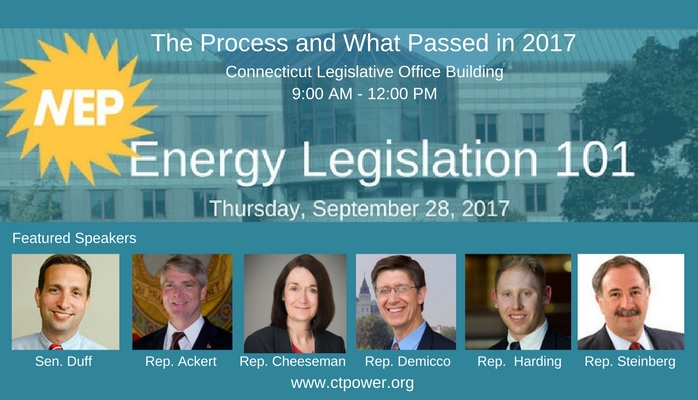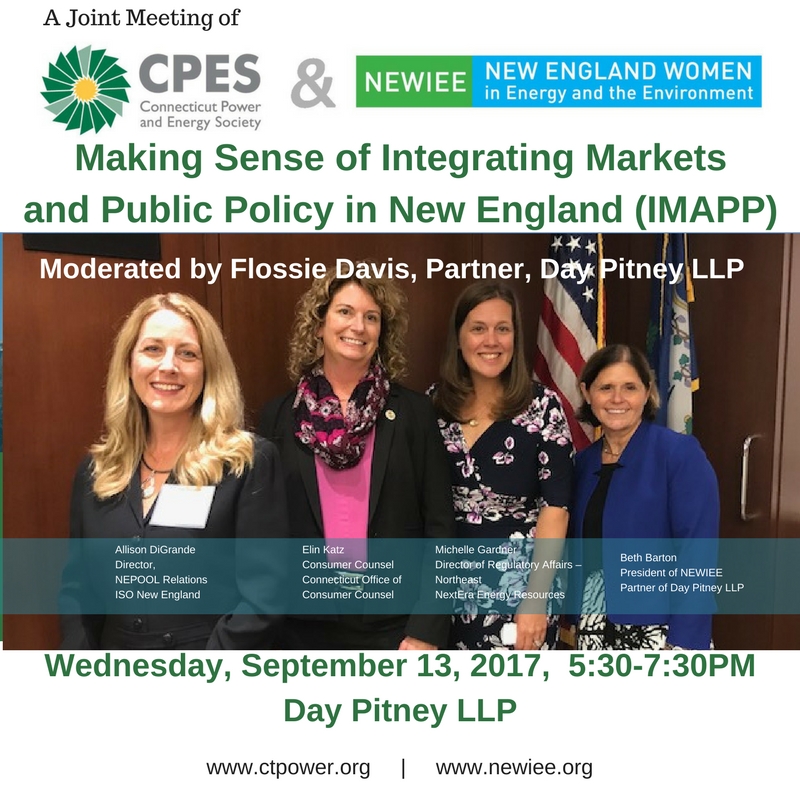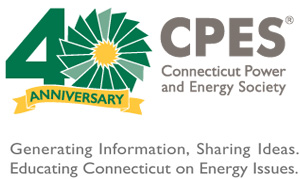Category Archives: 2017
CPES Policy Committee Update: August 7, 2017
NEP: Energy Legislation 101: The Process and What Passed in 2017

Half Day Event, 9am – Noon
Connecticut Legislative Office Building
Thursday, September 28, 2017
Lobbying 101 Presentation
Wrap Up:
CPES Holds Second 101 Series Event for New Energy Professionals!
On September 28, 2017, the Connecticut Power and Energy Society’s New Energy Professionals Committee hosted “Energy Legislation 101: The Process and What Passed in 2017” at the Legislative Office Building and State Capitol in Hartford, Connecticut. Energy Legislation 101 is the second in a series of informational sessions established to assist recently joined CPES members and those new to the industry as they become acclimated and involved within the organization. The overarching goal of the 101 series is to provide a meaningful overview of state agencies and businesses with whom professionals in the industry interact. While the event was geared toward New Energy Professionals, many established professionals were also in attendance.
The day began with an overview of the legislative process in Connecticut from Melissa Biggs, a partner at DePino, Nunez & Biggs, LLC, and Christopher Cordima, an attorney in the Connecticut Legislative Commissioners’ Office.
The overview was followed by a timely discussion of energy legislation that passed during the 2017 legislative session and what issues may arise next session. Joining the conversation were Senator Bob Duff, Representative Tim Ackert, Representative Holly Cheeseman, Representative Mike Demicco, Representative Stephen Harding, and Representative Jonathan Steinberg. All serve on the General Assembly’s Energy & Technology Committee, Environment Committee, or both!
The day ended with a tour of the Legislative Office Building and State Capitol.
Blurb:
Please join us as Connecticut’s key energy and environment legislative staff and leaders offer a three-part Energy Legislation 101 to CPES New Energy Professionals*! Come brush up on all the details of the legislative process. Continue into a timely discussion of the bills which become effective as of October 1st. Finish with a tour of the Legislative Office Building and Capitol.

This is a free event, but please register at your earliest convenience as space is limited.
Agenda:
9:00am – Networking, Coffee and Danish
(Second Floor Atrium of the Legislative Office Building)
9:30am – Energy Legislation 101: Basics and Procedures (Hearing Room 2E)
Melissa Biggs, DePino, Nunez & Biggs, LLC
Christopher Cordima, CT Legislative Commissioners’ Office
10:00am – Current and Future Legislation Discussion: A detailed and timely conversation about the energy bills that just passed and become effective as of October 1st. (Hearing Room 2E)
11:15am: (Optional) The League of Women Voters is offering a tour of the Legislative Office Building and Capitol
*This group is not limited to age range or years of experience. We welcome everyone to reach out to us.
The goal of the 101 series is to provide a meaningful overview of state agencies and businesses with whom professionals in our industry interact. While this series was established with our New Energy Professionals in mind, all are welcome.” – Alex Isaac, NEP Group Member
CPES Policy Committee Update: July 25, 2017
This update features policy, regulatory, legislative, and regional developments in Connecticut and New England. The policy updates are compiled by the CPES New Energy Professionals Team. If you are interested in learning more about the New Energy Professionals, the Policy Committee, or if you have ideas for future policy updates, we would welcome your input and feedback. Please send comments to Kathryn Dube, CPES Executive Director, via email: kdube@ctpower.org.
- MA Preliminary 2018 SREC I and II Minimum Standards and
Solar Program Administrator RFP - Consumers Fare Better With Competitive Electricity Market
REGIONAL NEWS:
Solar Program Administrator RFP Posted
Earlier today, the electric distribution companies issued a Request for Proposals to select a Solar Program Administrator for the SMART program. Interested bidders must be registered within the Eversource “SAP Ariba Sourcing” purchasing system. More details and a copy of the RFP can be found on DOER’s website.
Preliminary 2018 SREC I and II Minimum Standards
Pursuant to 225 CMR 14.07(2) and (3), the Department of Energy Resources (DOER) is required to calculate the Solar Carve-out and Solar Carve-out II Compliance Obligations and Minimum Standards for each Compliance Year by no later than August 30th of the preceding year. As has been the practice to date, DOER announces a preliminary Compliance Obligation and Minimum Standard prior to conducting the Solar Credit Clearinghouse Auctions (“Auctions”) each July. For Compliance Year 2018, the formula in 225 CMR 14.07(2)(g) will be used to calculate the Solar Carve-out Compliance Obligation, and the formula in 225 CMR 14.07(3)(e) and (f) will be used to calculate the Solar Carve-out II Compliance Obligation.DOER emphasizes that this is only a preliminary announcement and that final Minimum Standards will be announced no later than August 30th.
Solar Carve-out (SREC I Program) Based on the information available at this time, DOER estimates that the 2018 Compliance Obligation for the SREC I Program will be approximately 838,995 MWh and that the Minimum Standard will be approximately 1.7903%. Should this year’s SREC I Auction not fully clear in the first two rounds, the 2018 Compliance Obligation and Minimum Standard will be increased to 857,423 MWh and 1.8296%, respectively. The details of how this preliminary Minimum Standard was calculated are available on the DOER’s website.
Solar Carve-out II (SREC II Program) Pursuant to 225 CMR 14.07(3)(a)1, all Retail Electricity Suppliers are exempt from any incremental obligations resulting from the provisions contained in the RPS Class I Emergency Regulation filed on April 8, 2016, which expanded the Solar Carve-out II (SREC II) Program Capacity Cap. As such, it is necessary for DOER to establish a baseline Compliance Obligation and Minimum Standard that would have applied had the Emergency Regulation not been filed.
To determine this baseline Minimum Standard, DOER analyzed the percentage shares of MW qualified under each of the four SREC II Market Sectors at the time the extension was announced. DOER then multiplied these percentages by the original 947.7 MW SREC II Program Capacity Cap. DOER multiplied these totals by the applicable SREC Factors, a 13.71% expected capacity factor, and 8,760 hrs/year and determined the expected MWh/year that would have resulted had the SREC II Program Capacity Cap remained 947.7 MW. Lastly, DOER added the remaining auction certificates available from 2015 as well as the auction certificates and banked SREC II volume from the 2016 Compliance Filings. This yields a total baseline Compliance Obligation of 1,347,902 MWh and a Minimum Standard of 2.8762%
If the upcoming SREC II Auction does not fully clear in the first two rounds, the baseline Compliance Obligation and Minimum Standard for 2018 will be 1,591,279 MWh and 3.3955%, respectively.
Using all of the available information at this time, DOER has also calculated the preliminary 2018 SREC II Compliance Obligation and Minimum Standard for load under contracts signed on or after May 8, 2016. DOER has determined that the Compliance Obligation will be approximately 1,923,743 MWh and that the Minimum Standard will be approximately 4.1049%. Should this year’s SREC II Auction not fully clear in the first two rounds, the 2018 Compliance Obligation and Minimum Standard will be increased to 2,167,120 MWh and 4.6242%, respectively. The details of how this preliminary Minimum Standard was calculated are also available on the DOER’s website.
Next Steps
The first rounds of both the SREC and SREC II Solar Credit Clearinghouse Auctions are scheduled to take place on July 24, 2017. Should these auctions not fully clear, second and third rounds will be held as necessary on July 25, 2017 and July 28, 2017, respectively. Once both auctions have concluded, DOER will be able to make its final determination of the Compliance Obligations and Minimum Standards for 2018. The announcement of these final Minimum Standards will occur no later than August 30, 2017. More information on the auctions taking place later this month is available on the DOER’s auction website.
OP-ED FROM MORNING CONSULT, JULY 12, 2017:
CPES does not take a position on this Op-Ed piece; this is provided for informational purposes only to CPES members.
Consumers Fare Better With Competitive Electricity Markets
DARRIN PFANNENSTIEL
Policymakers across the country are grappling with a stunning transition under way in the United States’ $380 billion electricity sector. Electricity consumption is flat, cleaner energy sources are dramatically increasing market share while nuclear and fossil fuel generation plants struggle to maintain economic viability, and new consumer-empowering technology innovations promise to transform how households and businesses use energy.
The U.S. electricity sector hasn’t seen such foment since 20 years ago, when state and federal policymakers began to introduce competitive reforms to the staid monopoly-regulated electric utility industry. While the Federal Energy Regulatory Commission acted to establish the wholesale power markets that now dominate most of the country, many states acted to open up retail markets so that for the first time in more than a century electricity consumers could choose from among competing suppliers.
Indeed, until California’s well-intentioned but poorly conceived first-in-the-nation experience with electricity competition, it appeared that a majority of states across the country would restructure their electricity markets to enable competition. But after California, some states poised to enact restructuring declined to do so, and others that had adopted competitive reforms reversed course.
Nevertheless, slightly more than a dozen states and the District of Columbia, which account for one-third of all electricity generation and consumption in the country, persisted with the task. They learned from California’s mistakes and created vibrant retail competition programs that have grown and prospered over the past 20 years, benefiting consumers with abundant choices among increasingly innovative, clean and cost-competitive electricity product and service offerings.
So for two decades we’ve had what U.S. Supreme Court Justice Louis Brandeis described as laboratories of democracy at work, with one set of states preserving monopoly utility regulation while another set pursued competition and customer choice.
And as shown in a new white paper commissioned by the Retail Energy Supply Association, entitled “RESTRUCTURING RECHARGED — The Superior Performance of Competitive Electricity Markets 2008-2016,” the verdict is in: Consumers with competitive choice are disproportionately benefiting. Using U.S. Energy Information Administration data, the white paper by Philip R. O’Connor, Ph.D., former chairman of the Illinois Commerce Commission, found that competitive choice jurisdiction customers fared demonstrably better in terms of price, investment and efficiency than did those who remained under monopoly regulation.
Weighted average prices in the group of 35 monopoly states have risen nearly 15 percent while in the 14 competitive markets total weighted average prices have declined 8 percent. Inflation-adjusted price changes for major customer classes in choice and monopoly states are starkly different, declining 18 percent for customers in competitive jurisdictions compared to the experience in monopoly states.
It is no surprise then that relatively sophisticated commercial and industrial electricity customers have widely embraced competition, and we’ve a seen a majority of customers in those classes benefit by purchasing electricity from non-utility suppliers in competitive choice states, particularly as competition enables access to cleaner energy supply options. But residential customers are increasingly benefiting from the competitive marketplace too.
Between 2003 and 2008, the number of residential accounts served in competitive jurisdictions by non-utility providers more than tripled from about 2.3 million to 7.1 million, and more than doubled again since to average more than 16.4 million annually. For jobs-producing commercial and industrial customers, between 2003 and 2008 those served by non-utility suppliers grew 240 percent, from 436,000 to nearly 1.6 million. Since then we’ve seen a near doubling again with competitive commercial and industrial accounts averaging more than 2.9 million and exceeding 3 million in 2016.
Dr. O’Connor’s analysis also found a sharp contrast between the two sets of states in terms of innovation. Competitive choice jurisdictions are enabling innovation in customer-empowering alternatives such as “green” energy options and smart thermostats that allow customers to better manage how and when they use electricity. Monopoly utilities, meanwhile, are inherently inhospitable to innovation, his analysis found. This is especially important when one considers the many innovative ideas emerging from Silicon Valley that will power the electricity sector and consumers into a clean energy future.
It is against this backdrop of growing evidence that competitive markets are delivering real and tangible benefits in terms of pricing and innovation that policy makers in several states are beginning to consider once again taking steps to introduce competition in electricity to retail customers. Given the demonstrably superior performance of retail choice markets, a coming second wave of retail electricity market restructuring has begun, as evidenced by ongoing debates in Nevada and California.
Consumers want and expect choices. Given the stunning economic and technological transformation underway in the electricity industry, it makes little sense to cling to a monopoly regulatory model for electricity that is a vestige of 19th century economic thinking and a barrier to the efficient 21st century clean-energy economy that consumers and policymakers seek to embrace.
Darrin Pfannenstiel, senior vice president and associate general counsel for Stream, a Dallas-based competitive retail energy supplier, is president of the Retail Energy Supply Association, a broad and diverse group of retail energy suppliers who share the common vision that competitive retail electricity and natural gas markets deliver a more efficient, customer-oriented outcome than the regulated utility structure.
https://morningconsult.com/opinions/consumers-fare-better-competitive-electricity-markets/
Making Sense of Integrating Markets and Public Policy in New England (IMAPP): CPES / NEWIEE Joint Meeting
WRAP UP:
“Making Sense of IMAPP”
Integrating Markets and Public Policy in New England:
Sponsored by: Eversource, HQUS, Starion Energy, Robinson+Cole, DCO Energy, Globelé Energy, LLC

WRAP UP:
CPES and NEWIEE Host Joint Meeting on Integrating Markets and Public Policy (IMAPP) in New England
On September 13, 2017, the Connecticut Power and Energy Society (CPES) and New England Women in Energy and the Environment (NEWIEE) hosted a joint meeting in Hartford, Connecticut on an important regional topic—the integration of the region’s wholesale electricity markets with the public policy goals of the New England states. The meeting marked the third collaboration between CPES and NEWIEE, reflecting the organizations’ respective commitments to create opportunities to share information about hot topics in energy, while recognizing women who work in the industry. The panel discussion featured state and regional experts on energy, including Allison DiGrande, Director of NEPOOL Relations for ISO New England, Michelle Gardner, Director of Regulatory Affairs – Northeast for NextEra Energy Resources, and Elin Katz, Consumer Counsel for the State of Connecticut. Flossie Davis, Partner at Day Pitney LLP, moderated the panel and provided background on the stakeholder discussions launched by NEPOOL to consider potential market rule changes to integrate markets and public policy in New England.
Allison DiGrande set the stage for the discussion, explaining how state polices promoting the procurement of clean energy resources are impacting the region’s wholesale electricity markets. She explained the proposal the ISO has put forward to accommodate the states’ public policy goals in the near term—called Competitive Auctions with Sponsored Policy Resources—involving enhancements to the region’s Forward Capacity Market. She noted that the ISO’s proposal is intended to integrate the states’ sponsored policy resources into the Forward Capacity Market over time while preserving competitively based capacity pricing for other resources in New England to ensure resource adequacy. She stated that the ISO is currently working with stakeholders on design details and plans to file its proposal with the Federal Energy Regulatory Commission (FERC) by the end of the year for review and approval.
Michelle Gardner discussed a longer-term proposal offered by NextEra Energy, Conservation Law Foundation, and Brookfield Renewable aimed at achieving the states’ public policy goals through the wholesale electricity markets. She laid out the general framework for a proposed Forward Clean Energy Market intended to procure the clean energy attributes of resources needed to fulfill the states’ long-term greenhouse gas (GHG) reduction goals. She explained that the design proposal is intended to not only attract new clean energy resources but also retain existing clean energy resources to cost-effectively reduce GHG emissions in New England. She also described the proposal’s location-specific payments to focus incentives to develop new clean energy resources where they will displace the most CO2 emissions.
Elin Katz voiced her support for a solution that accommodates the states’ public policy goals, expressing concern over the willingness and ability of the six New England states to gain consensus over one set of public policy goals to achieve through the markets. She explained to attendees that the Connecticut Office of Consumer Counsel is an active and voting member of the End-User Sector of NEPOOL, which gives consumer interests a voice in stakeholder discussions. She also touched on the issue of Millstone Nuclear Power Station and how the debate over the plant’s future is indicative of the challenges associated with coming to agreement over matters of state policy.
___________________________________________________________________________________________________
Panel Description:
Since last August, market participants, policymakers, and other stakeholders have been discussing potential market rule changes to integrate the region’s wholesale electricity markets with the public policy goals of the New England states. Through that process, ISO New England has offered a conceptual approach to accommodate state policies in the near term, involving enhancements to the Forward Capacity Market. The region’s stakeholders are exploring several other concepts as well, including longer-term solutions aimed at achieving the states’ public policy goals, not simply accommodating them. How did we get here? How are consumers represented in these discussions?
Location:
Day Pitney LLP, 242 Trumbull Street, Hartford, CT 06103
Program:
- 5:30: Registration and networking reception
- 6:15: Welcoming remarks by NEWIEE and CPES Board Members
- Elizabeth C. Barton, NEWIEE President and Partner, Day Pitney LLC
- Joey Lee Miranda, CPES President and Partner, Robinson+Cole
- 6:30: Panel discussion: Making Sense of IMAPP: Integrating Markets and Public Policy in New England
- 7:30: Conclusion
